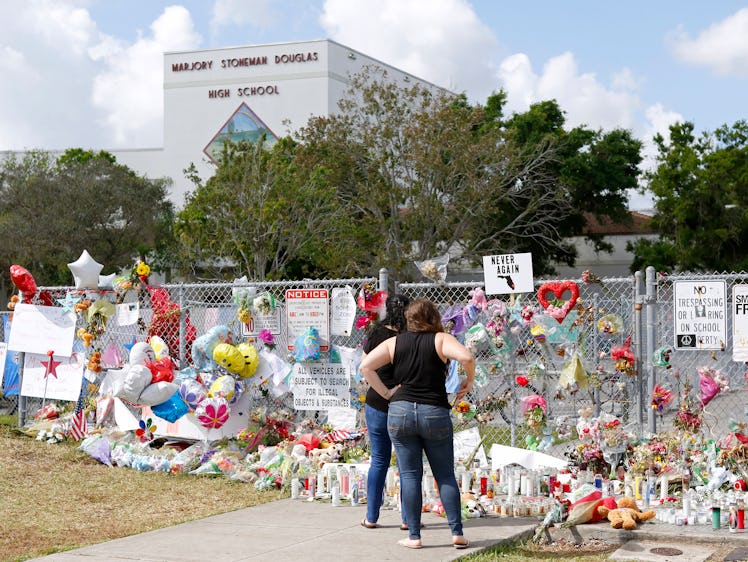
After Surviving Parkland, Here's What I Want Schools To Do About Gun Safety
Two years ago, I survived a shooting at my high school in Parkland, Florida. I was in debate class when we began to hear pops — at first, I didn’t register these sounds as gunshots. They couldn’t be. When my classmates and I realized they were, in fact, bullets, we ran for our lives. Following the shooting, I felt that my innocence was stripped away from me. But I also had a new sense of responsibility to ensure the horror I faced wouldn’t happen to anyone else.
After the shooting, we, the students of Marjory Stoneman Douglas High School, immediately sprang into action: organizing marches, rallies, and talking to the press. Looking back, it seems unimaginable, but there was an overwhelming feeling that we had no choice but to stop this horror from happening to anyone else. We were grieving, but we couldn’t allow gun violence to go unchecked. Since then, I’ve joined students across the nation in advocating for stronger gun laws.
After the shooting, my school, my city, and my friends were changed forever. My community will always have a wound unhealed. No one should have to face my reality of going to a school where their fellow classmates and teachers were killed. While schools are generally safe places for kids — mass shootings (including school shootings) make up less than 1% of all gun deaths in the United States — the reality is school no longer feels safe for many students. According to the Pew Research Center, a majority of American teens worry their school will be the next school to experience what happened at Marjory Stoneman Douglas, thanks in part to the lockdown drills students are enduring.
When it comes to what schools should prioritize, the answer isn’t more active shooter drills.
The most effective way to keep kids safe in schools is to implement proven policies and programs that prevent violence in our communities. The data on school shootings shows most shooters were students who showed warning signs and accessed guns in the homes of family, friends, or close relatives. Access needs to be disrupted. That can happen by passing red flag laws that empower law enforcement and families to temporarily remove a person’s access to guns when they present a serious risk to themselves or others, and by demanding parents and families store their guns securely.
There’s work to be done in our schools, too. Schools can become safer by implementing threat assessment programs that train teachers and educators how to safely intervene when there are signs a student is in crisis or poses a risk. Schools can provide students with access to more mental health professionals. The physical security of our schools should also be improved. These solutions don’t rely on turning schools into prisons, or trying to discipline students like they do in the criminal justice system, which often disproportionately harms students of color and those with disabilities. The fact is a school with a positive climate is a safer school.
It makes me sick to my stomach that students still have to practice for a shooting, even when we already experienced a real one.
When it comes to what schools should prioritize, the answer isn’t more active shooter drills — and it’s certainly not unannounced drills or drills that simulate gun violence. Schools are increasingly implementing ALICE-style drills that simulate an active shooter attack, and many drills, including those here in South Florida, are completely unannounced. This sparks fear in students who are already terrified their school will be the target of a shooting. It’s unacceptable. Studies have shown that people who go through options-based training like ALICE consistently perform “worse than people with no training whatsoever.” Students across the country are being traumatized for absolutely nothing.
Since the 2018 shooting, students at my high school have undergone active shooter drills regularly. These drills are a horrible reminder of what happened two years ago. In some of my classes, students have to turn off the lights and lie down because there are too many windows. It makes me sick to my stomach that students still have to practice for a shooting, even when we already experienced a real one. I know students all over the country feel the same sense of dread — even if they haven’t experienced the horror of a school shooting.
Students deserve to come to school and think about things like classes, AP tests, applying to college, friends, and sports. They shouldn’t have to worry about active shooters in their schools. Schools must do better by taking a holistic approach to safety. That starts with intervening before gun violence can even happen.
Sari Kaufman is a survivor of the Feb. 14, 2018 shooting at Marjory Stoneman Douglas High School in Parkland, Florida, a senior at Marjory Stoneman Douglas and a member of the Students Demand Action national advisory board.